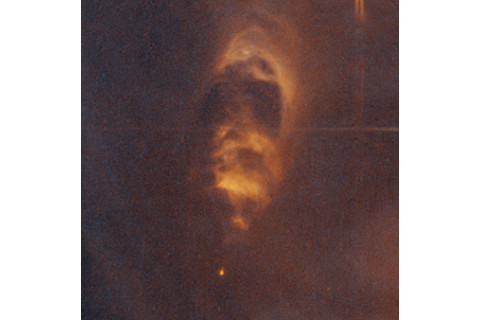When a human is a baby, it has a mass of a few kilos and eats milk. When a star is a baby, it has a mass of an octillion tons and eats sandwiches a trillion kilometers across. Don't believe me? Well good, because I'm being a little metaphorical. But still, this newly released Hubble image backs me up:

Isn't that gorgeous? You can get a bigger version, or a huge 3873 x 3943 pixel image. But what is it? It's a view of M43, a part of the vast Orion nebula complex, separated a bit from the more famous Orion Nebula. Like its big brother, stars are forming here... and I can show you how I know.

Just below and to the right of the bright star near the top of the image, you can see a star that has an odd shape. When zoomed in, as shown here, it looks a bit like an old style Cylon head, or a walrus. This shape is common, and is sometimes described as a sandwich shape. But it's really a cocoon! When a star forms, it begins as a cloud of gas and dust that rotates and collapses into a spinning disk. That thin disk is far more dense than the surrounding material, and blocks our view of it. Seen from the side, it's like a thin line cutting across the cloud. And that's exactly what we're seeing here. In the center of that oddly-shaped object, a star -- and perhaps a system of planets -- is busily forming. Eventually, the heat and light from the star will eat away (see? eating!) at the disk, and when the star settles down its solar wind will blow the rest away. After a few hundred million years you'd have no idea the disk was ever there... except for its pedigree in the planetary system, with all the planets orbiting in the same plane as the star's rotation, a remnant of the spin of the disk itself.

Not everything is so easily explained. When I first saw this object (shown here) in the original image above I was a bit baffled, but looking at the high-res version made it clear. Young stars may still be surrounded by those dense disks, but they can also blow long jets of matter from their poles. This material can be moving at hundreds of kilometers per second, and it slams into the surrounding gas and dust. The jet slows, puffs out, and can create long tear-drop shaped formations like this one. It's clearly coming from this star; you can even see a tiny line coming from the star itself pointed at the bubble; that's almost certainly the jet very near the star. Oddly, though, there's only one bubble. In my mind that can mean one of three things: 1) There is only one jet coming from a single pole of the star, which seems unlikely; 2) there is only dense material on one side of the star so we only see one of the jets hitting that material; or 3) I'm totally wrong about what this object is*. The image, incidentally, is a combination of visible light (shown in blue) and near infrared (red). The whole image is only 3 arcminutes across, meaning you could block it out in the sky with a grain of sand held at arm's length. Imagine! All those stars, all that violence, yet it can be silhouetted by a small crystal found by the billions on Earth's beaches. That should give you a sense of how far away this view is; the stars are well over a thousand light years away. But given how loud and messy these particular babies are, that sounds like a comfortable distance to me. Image credit: ESA/Hubble & NASA
^* That last part is clearly ridiculous, of course! But I have to at least seem modest and honest.
Related posts: - The Orion VISTA - A new old view of an old friend - Hubble celebrates 20 years in space with a jaw-dropper - C-beams off the shoulder of Orion













